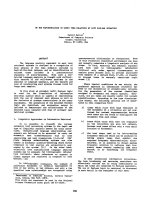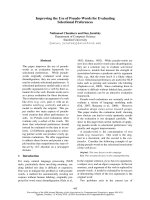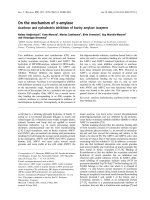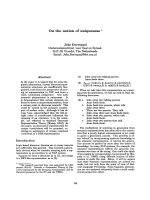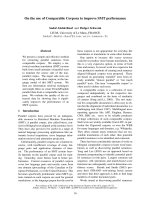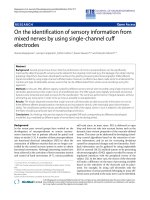Báo cáo hóa học: " ´ On the Use of Pade Approximation for Performance Evaluation of Maximal Ratio Combining Diversity over Weibull Fading Channels" potx
Bạn đang xem bản rút gọn của tài liệu. Xem và tải ngay bản đầy đủ của tài liệu tại đây (3.46 MB, 7 trang )
Hindawi Publishing Corporation
EURASIP Journal on Wireless Communications and Networking
Volume 2006, Article ID 58501, Pages 1–7
DOI 10.1155/WCN/2006/58501
On the Use of Pad
´
e Approximation for Performance
Evaluation of Maximal Ratio Combining Diversity
over Weibull Fading Channels
Mahmoud H. Ismail and Mustafa M. Matalgah
Department of Electrical Engineer ing, Center for Wireless Communications, The University of Mississippi,
University, MS 38677-1848, USA
Received 1 April 2005; Revised 18 August 2005; Accepted 11 October 2005
Recommended for Publication by Peter Djuric
We use the Pad
´
e approximation (PA) technique to obtain closed-form approximate expressions for the moment-generating func-
tion (MGF) of the Weibull random variable. Unlike previously obtained closed-form exact expressions for the MGF, which are
relatively complicated as being given in terms of the Meijer G-function, PA can be used to obtain simple rational expressions for
the MGF, which can be easily used in further computations. We illustrate the accuracy of the PA technique by comparing its results
to either the existing exact MGF or to that obtained via Monte Carlo simulations. Using the approximate expressions, we analyze
the per formance of digital modulation schemes over the single channel and the multichannels employing maximal ratio combin-
ing (MRC) under the Weibull fading assumption. Our results show excellent agreement with previously published results as well
as with simulations.
Copyright © 2006 M. H. Ismail and M. M. Matalgah. This is an open access article distributed under the Creative Commons
Attribution License, which permits unrestricted use, distribution, and reproduction in any medium, provided the original work is
properly cited.
1. INTRODUCTION
The use of the Weibull distribution as a statistical model that
better describes the actual short term fading phenomenon
over outdoor as well as indoor wireless channels has been
proposed decades ago [1–3]. More recently, the appropri-
ateness of the Weibull distribution has been further con-
firmed by experimental data collected in the cellular band
by two independent groups in [4, 5]. Since then, the Weibull
distribution has attracted much attention among the radio
community. In particular, the performance of receive diver-
sity systems over Weibull fading channels has been exten-
sively studied in [6–13]. Also, a closed-form expression for
the moment-generating function (MGF) of the Weibull ran-
dom variable (RV) was obtained in [7] when the Weibull fad-
ing parameter (which will be defined in the sequel), usually
denoted by m, assumes only integer values. Another expres-
sion for the MGF for arbitrary values of m was also derived
in [8]. Both expressions were given in terms of the Meijer G-
function and were used for evaluating the performance of
digital modulation schemes over the single-channel recep-
tion and multichannel diversity reception assuming Weibull
fading. Also, in [14], the second-order statistics and the ca-
pacity of the Weibull channel have been derived. Finally,
we have analyzed the performance of cellular networks with
composite Weibull-lognormal faded links as well as the per-
formance of MRC diversity systems in Weibull fading in
presence of cochannel interference (CCI) in terms of outage
probability in [15, 16], respectively.
The closed-form expressions provided in [7, 8 ], despite
being the first of their kind in the open literature and de-
spite having a very elegant form, suffer from a major draw-
back. The expressions involve the Meijer G-function, which,
although easy to evaluate by itself using the modern math-
ematical packages such as Mathematica and Maple, these
packages fail to handle integrals involving this function and
lead to numerical instabilities and erroneous results when m
increases. This renders the expressions impractical from the
ease of computation point of view. Hence, it is highly desir-
able to find alternative closed-form expressions for the MGF
of the Weibull random variable (RV) that are simple to evalu-
ate and in the same time can be used for arbitrary values of m.
Pad
´
e approximation (PA) is a well-known method that is
used to approximate infinite power series that are either not
2 EURASIP Journal on Wireless Communications and Networking
guaranteed to converge, converge very slowly or for which a
limited number of coefficients is known [17, 18]. This tech-
nique was recently used for outage probability calculation in
diversity s ystems in Nakagami fading in [19]. The approxi-
mation is given in terms of a simple rational function of ar-
bitrary numerator and denominator orders. In this paper, we
illustrate how this technique can be used to obtain simple-to-
evaluate approximate rational expressions for the MGF of the
Weibull RV based on the knowledge of its moments. We then
use these expressions to evaluate the performance of linear
digital modulations over flat Weibull fading channels in the
case of both single-channel reception and multichannel re-
ception employing maximal ratio combining (MRC).
The rest of the paper is organized as follows. In Section 2,
we give a brief overview of the Pad
´
e approximation tech-
nique. In Section 3, we apply this technique to the prob-
lem at hand. The performance of digital modulation sys-
tems over the Weibull fading channel is then revisited in
Section 4. Examples and numerical results as well as compar-
isons with previously published results in the literature and
Monte Carlo simulations are provided in Section 5 before the
paper is finally concluded in Section 6 .
2. PAD
´
E APPROXIMATION OVERVIEW
Let g(z) be an unknown function given in terms of a power
series in the variable z
∈ C, the set of complex numbers,
namely,
g(z)
=
∞
n=0
c
n
z
n
, c
n
∈ R,(1)
where
R is the set of real numbers. There are several reasons
to look for a rational approximation for the series in (1). The
series might be divergent or converging too slowly to be of
any pr actical use. Also, it is possible that a compact rational
form is needed in order to be used in later computations.
Not to mention the fact that it might be possible that only
few coefficients of
{c
n
} are known [17].ThePAmethodis
capable of dealing with all the problems mentioned above.
In par ticular, it can capture the limiting behavior of a power
series in a rational form.
The one-point PA of order [N
p
/N
q
], P
[N
p
/N
q
]
(z), is defined
from the series g(z) as a rational function by [17, 18]
P
[N
p
/N
q
]
(z) =
N
p
n=0
a
n
z
n
N
q
n=0
b
n
z
n
,(2)
where the coefficients
{a
n
} and {b
n
} are defined such that
N
p
n=0
a
n
z
n
N
q
n=0
b
n
z
n
=
N
p
+N
q
n=0
c
n
z
n
+ O
z
N
p
+N
q
+1
,(3)
with O(z
N
p
+N
q
+1
) representing the terms of order higher than
N
p
+ N
q
. It is s traightforward to see that the coefficients {a
n
}
and {b
n
} can be easily obtained by matching the coefficients
of like powers on both sides of (3). Specifically, taking b
0
= 1,
without loss of generality, one can find that
N
q
n=0
b
n
c
N
p
−n+j
= 0, 1 ≤ j ≤ N
q
,(4)
or equivalently,
N
q
n=1
b
n
c
N
p
−n+j
=−c
N
p
+ j
,1≤ j ≤ N
q
. (5)
The above equations form a system of N
q
linear equations for
the N
q
unknown denominator coefficients. This system can
be wr itten in matrix form as
Cb
=−c,(6)
where
b
=
b
N
q
···b
k
···b
1
T
,
c
=
c
N
p
+1
···c
N
p
+k+1
···c
N
p
+N
q
T
,
C
=
⎛
⎜
⎜
⎜
⎜
⎜
⎜
⎜
⎜
⎝
c
N
p
−N
q
+1
c
N
p
−N
q
+2
c
N
p
.
.
.
.
.
.
.
.
.
.
.
.
c
N
p
−N
q
+k
c
N
p
−N
q
+k+1
c
N
p
+k−1
.
.
.
.
.
.
.
.
.
.
.
.
c
N
p
c
N
p
+1
c
N
p
+N
q
−1
⎞
⎟
⎟
⎟
⎟
⎟
⎟
⎟
⎟
⎠
,
(7)
with (
·)
T
representing the transpose operation. After solving
the matrix equation in (6), the set
{a
n
} can be obtained by
a
j
= c
j
+
min(N
q
, j)
i=1
b
j
c
j−i
,0≤ j ≤ N
p
. (8)
An important remark is now in order. It mig h t seem that the
choice of the values of N
q
and N
p
is completely arbitrary.
This, in fact, is not accurate. An insightful look at (6)re-
veals that in order to be able to uniquely solve such system
of equations, it is necessary to have
|C| = 0, where |·|is
the determinant. In [17], using what we refer to as the rank-
order plots, it is shown that there exists a value of N
q
above
which the matrix C becomes rank deficient. This clearly rep-
resents an upper bound on the permissible values of N
q
. Also,
as mentioned in [20], N
p
is chosen to be equal to N
q
− 1as
this guarantees the convergence of the PA. In this paper, we
take N
q
such that it guarantees the uniqueness of the solution
of (6)andN
p
= N
q
− 1.
3. APPLICATION TO THE WEIBULL MGF
The MGF of an RV X>0isdefinedas
M
X
(s) = E
e
−sX
=
∞
0
e
−sx
f
X
(x)dx,(9)
where
E(·) is the expectation operator and f
X
(x) is the prob-
ability density function (PDF) of X. The PDF of the Weibull
M. H. Ismail and M. M. Matalgah 3
RV is given by
f
X
(x) =
mx
m−1
γ
exp
−
x
m
γ
, x ≥ 0, (10)
where m>0 is usually referred to as the Weibull distribu-
tion fading parameter and γ>0 is a parameter related to
the moments and the fading parameter of the distribution.
As mentioned earlier, a closed-form expression available for
M
X
(s, m, γ), the MGF of the Weibull RV with parameters
(m, γ), is provided in [8] and is restated here for convenience:
M
X
(s, m, γ) =
m
γ
(k/p)
1/2
(p/s)
m
(2π)
(p+k)/2
× G
k,p
p,k
1
γ
k
s
p
p
p
k
k
Δ(p,1−m)
Δ(k,0)
,
(11)
where p and k are the minimum integers chosen such that
m
= p/k, Δ(n, ζ) = ζ/n,(ζ+1)/n, ,(ζ+n−1)/n and G
m,n
p,q
(·)
is the Meijer G-function [21, Equation (9.301)]. Based on the
discussion presented in Section 1, it is required to find an al-
ternative closed-form expression for the MGF which is sim-
pler to use in computations and in the same time valid for
any value of m. Towards that end, we use the PA technique
as follows. It is interesting to note that the moments of the
Weibull RV are known in closed-form and are given by [10]
E
X
n
=
γ
n/m
Γ
1+
n
m
, (12)
where Γ(
·) is the Gamma function. Using the Taylor series
expansion of e
−sX
, the MGF can be expressed in terms of a
power series a s
M
X
(s, m, γ) =
∞
n=0
(−1)
n
n!
E
X
n
s
n
=
∞
n=0
c
n
(m, γ)s
n
, (13)
where c
n
(m, γ) = ((−1)
n
/n!)γ
n/m
Γ(1 + n/m). The infinite
series in (13) is not guaranteed to converge for all values
of s. Furthermore, it is not possible to truncate the series
since it is not clear what the truncation criterion is and
again, convergence is not guaranteed. However, comparing
(13)to(1), it is clear that a rational approximate expres-
sion for M
X
(s, m, γ) can be obtained using the methodology
outlined in Section 2. In the following, we will denote the
approximate expression for the MGF of a Weibull RV with
parameters (m, γ) having a denominator with order N
q
by
P
[N
q
−1/N
q
]
(s, m, γ).
4. PERFORMANCE OF DIGITAL MODULATIONS
OVER THE WEIBULL FADING CHANNEL
In [7], based on the obtained closed-form expression for the
Weibull MGF, and using the MGF approach [22], a compre-
hensive study of the performance of digital modulations over
the Weibull slow flat-fading channel has been conducted. It
is well known that, in general, the performance of any com-
munication system, in terms of bit error rate (BER), symbol
error rate (SER), or signal outage, will depend on the statis-
tics of the signal-to-noise ratio (SNR). Assuming that both
the average signal and noise powers are unity, then the SNR
will be equal to the squared channel amplitude, X
2
.Oneof
the interesting properties of the Weibull RV with parame-
ters (m, γ) is that raising it to the kth power results in an-
other Weibull RV with parameters (m/k, γ). Hence, for a fad-
ing channel having a Weibull distributed amplitude with pa-
rameters (m, γ), the SNR is clearly Weibull distributed with
parameters (m/2, γ). Due to the inapplicability of the MGF
closed-form expression in [7] to the noninteger values of m,
only results pertaining to integer values of m/2(or,equiva-
lently, to even integer values of m) were presented therein.
Even if the expression in (11) is to be used, which is valid
for arbitrary values of m, no software package will be able
to handle the integrations involving the resulting high-order
Meijer G-function [8]. Now, since the approximate expres-
sion obtained via the PA technique is very simple and does
not have any restriction on the values of m, it is now possible
to very easily obtain performance results for odd integer as
well as noninteger values of m.
For convenience, we note here some of the key expres-
sions presented in [7] that are relevant to our discussion. For
an MRC system with L identical bra nches, the outage proba-
bility, P
out,MRC
(ζ) P(SNR
MRC
<ζ), is given by
P
out,MRC
(ζ) =
1
2πj
+ j∞
−
j∞
M
X
(s, m/2, γ)
L
s
e
sζ
ds, (14)
where M
X
(s, m/2, γ) is the MGF of the SNR per branch, is
a properly chosen constant in the region of convergence in
the complex s-plane, and SNR
MRC
is the total SNR, which is
equal to the sum of the branches SNRs. For the same system
employing M-ary phase shift keying (M-PSK), the average
SER can be found from
SER
M−PSK
=
1
π
(M−1)π/M
0
M
X
g
PSK
sin
2
φ
, m/2, γ
L
dφ,
(15)
where g
PSK
= sin
2
(π/M). Finally, for M-ary quadrature am-
plitude modulation (M-QAM), the average SER is given by
SER
M−QAM
=
4
π
1 −
1
√
M
×
π/2
0
M
X
g
QAM
sin
2
φ
, m/2, γ
L
dφ
−
π/4
0
M
X
g
QAM
sin
2
φ
, m/2, γ
L
dφ
,
(16)
4 EURASIP Journal on Wireless Communications and Networking
543210−1−2−3−4−5
ω
−0.4
−0.2
0
0.2
0.4
0.6
0.8
1
R(MGF(jω))
Exact, γ =1
Exact, γ =2
Exact, γ =3.5
Exact, γ =7.2
Pad
´
e approximation
(a)
543210−1−2−3−4−5
ω
−0.8
−0.6
−0.4
−0.2
0
0.2
0.4
0.6
0.8
(MGF(jω))
Exact, γ =1
Exact, γ =2
Exact, γ =3.5
Exact, γ =7.2
Pad
´
e approximation
(b)
Figure 1: Pad
´
e approximation P
[4/5]
( jω, m, γ) and exact MGF using (11)form = 2 and different values of γ: (a) real part and (b) imaginary
part.
where g
QAM
= 3/2(M − 1). Clearly, using the rational ap-
proximation for the MGF provided by the PA technique, all
the integrals in (14) through (16) can be easily evaluated nu-
merically and the result is guaranteed to be very stable. In
fact some of the integrals, like the one in (14)canbefound
in closed form as it is equivalent to the problem of finding
the inverse Laplace transform of a rational function, which
can be easily solved using the partial fractions expansion.
5. EXAMPLES AND NUMERICAL RESULTS
5.1. Weibull MGF examples
In this section, we first illustrate through some examples the
efficiency and accuracy of the PA technique when approxi-
mating the MGF of the Weibull RV.
Consider the interesting case of m
= 1. In this case, it
is easy to check that C is rank deficient except for N
q
= 1.
Hence, we choose N
q
= 1andN
p
= 0. The only unknown,
b
1
, can now be easily found from b
1
=−c
1
(1, γ)/c
0
(1, γ) = γ.
Also, a
0
= c
0
(1, γ) = 1.TheapproximateMGFinthiscaseis
thus given by
P
[0/1]
(s,1,γ) =
1
1+γs
. (17)
Interestingly, in the special case of m
= 1, the Weibull distri-
bution reduces to the exponential distribution with parame-
ter 1/γ, which has an MGF, M
X
(s,1,γ) = 1/(1 + γs), which
is exactly the same expression given in (17). Hence, the PA
technique leads to an exact expression for the special case of
m
= 1.
We now present some results for different combinations
of m and γ. We use the PA with N
q
= 4, that is, P
[4/5]
(s, m, γ)
as an approximation for the MGF. For example, the PA for
the MGF with m
= 2andγ = 3.5isfoundtobe
P
[4/5]
(s,2,3.5)
=
1+0.328s+0.117s
2
+7.119×10
−3
s
3
+2.608 ×10
−4
s
4
1+1.1986s+1.659s
2
+0.734s
3
+0.173s
4
+0.018s
5
.
(18)
Figure 1 shows the real and imaginary parts of both the
PA and the exact MGF using (11)versusω,wheres
= jω,
j
=
√
−1, for m = 2 and different values of γ. Clearly, there
is a perfect agreement between both expressions. It is now of
interest to inspect the accuracy of the PA for noninteger val-
ues of m. For the sake of comparison, we revert to obtaining
the MGF via Monte Carlo simulations this time. In Figure 2,
we again plot the real and imaginary par ts of the PA along
with those of the MGF from simulations. From the plots, it
is evident that the PA can be used to give a very accurate es-
timate of the MGF for arbitrary values of m and γ. Note that
if the accuracy is not satisfactory for some cases, it is always
possible to choose a higher value of N
q
to enhance the accu-
racy as long as the matrix C is full r a nk.
5.2. Communication over the Weibull fading channel
Figure 3 shows the approximate outage probability curves for
a dual-branch MRC system (L
= 2) versus the average SNR
per branch,
E(X
2
). For these curves, either P
[4/5]
(s, m, γ)or,
if
|C| is found to be 0 , P
[3/4]
(s, m, γ) is used. For the even in-
teger values of m, the outage probability obtained using the
M. H. Ismail and M. M. Matalgah 5
543210−1−2−3−4−5
ω
−0.8
−0.6
−0.4
−0.2
0
0.2
0.4
0.6
0.8
1
R(MGF(jω))
m =2.5, γ =1.5
m =3.3, γ =2.5
m =1.25, γ =0.5
m =0.8, γ =1
Pad
´
e approximation
(a)
543210−1−2−3−4−5
ω
−1
−0.8
−0.6
−0.4
−0.2
0
0.2
0.4
0.6
0.8
1
(MGF(jω))
m =2.5, γ =1.5
m =3.3, γ =2.5
m =1.25, γ =0.5
m =0.8, γ =1
Pad
´
e approximation
(b)
Figure 2: Pad
´
e approximation P
[4/5]
( jω, m, γ) and MGF obtained via Monte Carlo simulations for different combinations of noninteger m
and γ: (a) real part and (b) imaginary part.
18161412108642
AverageSNRperbranch(dB)
10
−5
10
−4
10
−3
10
−2
10
−1
10
0
Outage probability
Simulations, m =1.5
Simulations, m =2
Simulations, m =2.5
Simulations, m =3
Simulations, m =3.5
Simulations, m =4
Exact (10) (even integers)
Pad
´
e approximation
Figure 3: Simulated and PA outage probability for a dual-branch
MRC system over Weibull fading channel for different values of m.
The outage probability obtained using the exact expression is also
shown for even integer values of m.
exact expression is also shown. Monte Carlo simulations are
provided for all the cases as well. It is evident that the approx-
imate results are in perfect ag reement with the simulations
and the exact expression.
20181614121086420
AverageSNRperbranch(dB)
10
−5
10
−4
10
−3
10
−2
10
−1
10
0
SER
Pad
´
e approximations
Exact expression
m =2, single
m =4, single
m =2,MRC
m =4,MRC
Figure 4: Exact and PA SER for 8-PSK with single- and dual-branch
MRC channels for m
= 2and4.
The SER of an 8-PSK system is depicted in Figures 4
and 5. Comparison is first established with the exact SER for
the two cases of m
=2andm =4. Again, perfect matching
between the two curves is noticed. In Figure 5, the case of
single-channel and dual-branch MRC system with odd and
noninteger values of m is considered. Finally, similar results
for the case of 16-QAM are presented in Figures 6 and 7.
6 EURASIP Journal on Wireless Communications and Networking
20181614121086420
AverageSNRperbranch(dB)
10
−5
10
−4
10
−3
10
−2
10
−1
10
0
SER
MRC, L =2
Single channel
m =2.5
m =3
m =3.5
Figure 5: PA SER for 8-PSK with single- and dual-branch MRC
channels for different noninteger and odd integer values of m.
20181614121086420
AverageSNRperbranch(dB)
10
−5
10
−4
10
−3
10
−2
10
−1
10
0
SER
Pad
´
e approximations
Exact expression
m =2, single
m =4, single
m =2,MRC
m =4,MRC
Figure 6: Exact and PA SER for 16-QAM with single- and dual-
branch MRC channels for m
= 2and4.
6. CONCLUSIONS
In this paper, we illustrated how the PA technique can be
used to find simple closed-form approximate expressions for
the MGF of the Weibull RV. Several examples have been
presented, which show perfect agreement between the ap-
proximate technique and a previously published closed-form
exact expression. When the exact expression is difficult to
handle numerically, comparison with Monte Carlo simu-
lations was performed. Using the PA technique, we also
analyzed the performance of digital modulations over the
20181614121086420
AverageSNRperbranch(dB)
10
−4
10
−3
10
−2
10
−1
10
0
SER
MRC, L =2
Single channel
m =3.5
m =3
m =2.5
Figure 7: PA SER for 16-QAM with single- and dual-branch MRC
channels for different noninteger and odd integer values of m.
Weibull fading channel with single- and multichannel MRC
reception. We showed that the approximate results for the
SER or outage probability match very well the exact results.
We also presented a new set of results for the cases of odd
and noninteger values of the Weibull fading parameter. The
PA technique indeed proves to be an invaluable tool in the
performance analysis of communications over the Weibull
fading channels.
ACKNOWLEDGMENT
This work was suppor ted in part by NASA EPSCoR under
Grant NCC5-574 and in part by the School of Engineering at
The University of Mississippi.
REFERENCES
[1] N. H. Shepherd, “Radio wave loss deviation and shadow loss at
900 MHz,” IEEE Transactions on Vehicular Technology, vol. 26,
no. 4, pp. 309–313, 1977.
[2] “Coverage prediction for mobile radio systems operating in
the 800/900 MHz frequency range,” IEEE Transactions on Ve-
hicular Technology, vol. 37, no. 1, pp. 3–72, 1988.
[3] H. Hashemi, “The indoor radio propagation channel,” Pro-
ceedings of the IEEE, vol. 81, no. 7, pp. 943–968, 1993.
[4] G. Tzeremes and C. G. Christodoulou, “Use of Weibull distri-
bution for describing outdoor multipath fading,” in Proceed-
ings of IEEE Antennas and Propagation Society International
Symposium, vol. 1, pp. 232–235, San Antonio, Tex, USA, June
2002.
[5] G. L. Siqueira and E. J. A. V
´
asquez, “Local and global signal
variability statistics in a mobile urban environment,” Wireless
Personal Communications, vol. 15, no. 1, pp. 61–78, 2000.
[6] M S. Alouini and M. K. Simon, “Performance of general-
ized selection combining over Weibull fading channels,” in
M. H. Ismail and M. M. Matalgah 7
Proceedings of IEEE 54th Vehicular Technology Conference
(VTC ’01), vol. 3, pp. 1735–1739, Atlantic City, NJ, USA, Oc-
tober 2001.
[7] J.Cheng,C.Tellambura,andN.C.Beaulieu,“Performanceof
digital linear modulations on Weibull slow-fading channels,”
IEEE Transactions on Communications, vol. 52, no. 8, pp. 1265–
1268, 2004.
[8] N. C. Sagias, G. K. Karagiannidis, and G. S. Tombras, “Error-
rate analysis of switched diversity receivers in Weibull fading,”
Electronics Le tters, vol. 40, no. 11, pp. 681–682, 2004.
[9] N. C. Sagias, G. K. Karagiannidis, D. A. Zogas, P. T. Math-
iopoulos, S. A. Kotsopoulos, and G. S. Tombras, “Performance
of diversity receivers over non-identical Weibull fading chan-
nels,” in Proceedings of IEEE 59th Vehicular Technology Confer-
ence (VTC ’04), vol. 1, pp. 480–484, Milan, Italy, May 2004.
[10] N. C. Sagias, D. A. Zogas, G. K. Karagiannidis, and G. S.
Tombras, “Performance analysis of switched diversity receivers
in Weibull fading,” Electronics Letters, vol. 39, no. 20, pp. 1472–
1474, 2003.
[11] N. C. Sagias, P. T. Mathiopoulos, and G. S. Tombras, “Selec-
tion diversity receivers in Weibull fading: outage probability
and average signal-to-noise ratio,” Electronics Letters, vol. 39,
no. 25, pp. 1859–1860, 2003.
[12] N. C. Sagias, G. K. Karagiannidis, D. A. Zogas, P. T. Math-
iopoulos, and G. S. Tombras, “Performance analysis of dual
selection diversity in correlated Weibull fading channels,” IEEE
Transactions on Communications, vol. 52, no. 7, pp. 1063–
1067, 2004.
[13] G. K. Karagiannidis, D. A. Zogas, N. C. Sagias, S. A. Kot-
sopoulos, and G. S. Tombras, “Equal-gain and maximal-ratio
combining over nonidentical Weibull fading channels,” IEEE
Transactions on Wireless Communications,vol.4,no.3,pp.
841–846, 2005.
[14] N. C. Sagias, D. A. Zogas, G. K. Karagiannidis, and G. S.
Tombras, “Channel capacity and second-order statistics in
Weibull fading,” IEEE Communications Letters, vol. 8, no. 6,
pp. 377–379, 2004.
[15] M. H. Ismail and M. M. Matalgah, “Outage probability in mul-
tiple access systems with Weibull-faded lognormal-shadowed
communication links,” in Proceedings of IEEE 62nd Semian-
nual Vehicular Technology Conference (VTC ’05),Dallas,Tex,
USA, September 2005, (available on CD).
[16] M. H. Ismail and M. M. Matalgah, “Performance evaluation
of maximal ratio combining diversity over the Weibull fading
channel in presence of co-channel interference,” in Proceedings
of IEEE Wireless Communications and Networking Conference
(WCNC’ 06), Las Vegas, Nev, USA, April 2006.
[17] H. Amindavar and J. A. Ritcey, “Pad
´
e approximations of prob-
ability density functions,” IEEE Transactions on Aerospace and
Electronic Systems, vol. 30, no. 2, pp. 416–424, 1994.
[18] S. P. Suetin, “Pad
´
e approximants and efficient analytic con-
tinuation of a power series,” Russian Mathematical Surveys,
vol. 57, no. 1, pp. 43–141, 2002.
[19] G. K. Karagiannidis, “Moments-based approach to the perfor-
mance analysis of equal gain diversity in Nakagami-m fading,”
IEEE Transactions on Communications, vol. 52, no. 5, pp. 685–
690, 2004.
[20] E. Jay, J P. Ovarlez, and P. Duvaut, “New methods of radar
performances analysis,” Signal Processing, vol. 80, no. 12, pp.
2527–2540, 2000.
[21] I. S. Gradshteyn and I. M. Ryzhik, Table of Integrals, Series and
Products, Academic Press, San Diego, Calif, USA, 2000.
[22] M. K. Simon and M S. Alouini, Digital Communication ove r
Fading Channels: A Unified Approach to Performance Analysis,
John Wiley & Sons, New York, NY, USA, 2000.
Mahmoud H. Ismail received the B .S. de-
gree (with highest honors) in electronics
and electrical communications engineering
and the M.S. degree in communications
engineering both from Cairo University,
Giza, Egypt, in 2000 and 2002, respec-
tively. From August 2000 to August 2002,
he was a Research and Teaching Assistant in
the Department of Electronics and Electri-
cal Communications Engineering at Cairo
University. He was with the Ohio State University, Columbus,
Ohio, USA, during the academic year 2002–2003. He is currently
a Research Assistant in the Center for Wireless Communications
(CWC) at The University of Mississippi, Miss, USA, where he is
pursuing his Ph.D. degree in electrical engineering. His research is
in the general area of wireless communications with emphasis on
performance evaluation of next-generation wireless systems, com-
munications over fading channels, and error-control coding. He is
the recipient of the Ohio State University Fellowship in 2002, The
University of Mississippi Summer Assistantship Award in 2004 and
2005, The University of Mississippi Dissertation Fellowship Award
in 2006, and the Best Paper Award presented at the 10th IEEE
Symposium on Computers and Communications (ISCC 2005), La
Manga del Mar Menor, Spain. He served as a reviewer for several
refereed journals and conferences and he is a Member of Sigma Xi,
Phi Kappa Phi, and a Student Member of the IEEE.
Mustafa M. Matalgah received his Ph.D. in
electrical and computer engineering in 1996
from The University of Missouri, Columbia,
M.S. degree in electrical engineering in 1990
from Jordan University of Science and Tech-
nology, and B.S. degree in electrical engi-
neering in 1987 from Yarmouk University,
Irbid, Jordan. From 1996 to 2002, he was
with Sprint, Kansas City, Mo, USA, where
he led various projects dealing with SONET
transmission systems and the e valuation and assessment of 3G
wireless communication emerging technologies. In 2000, he was
an Adjunct Visiting Assistant Professor at The University of Mis-
souri, Kansas City, Mo, USA. Since August 2002, he has been with
The University of Mississippi in Oxford as an Assistant Professor in
the Electrical Engineering Department. His technical and research
interests and experience span the fields of emerging wireless com-
munications systems, signal processing, optical binary matched fil-
ters, and communication networks. He has published more than
60 technical research and industrial documents in these areas. He
received several certificates of recognition for his work accomplish-
ments in the industry and academia. He is the recipient of the Best
Paper Award of the IEEE ISCC 2005, La Manga del Mar Menor,
Spain. He served on several international conferences committees.


